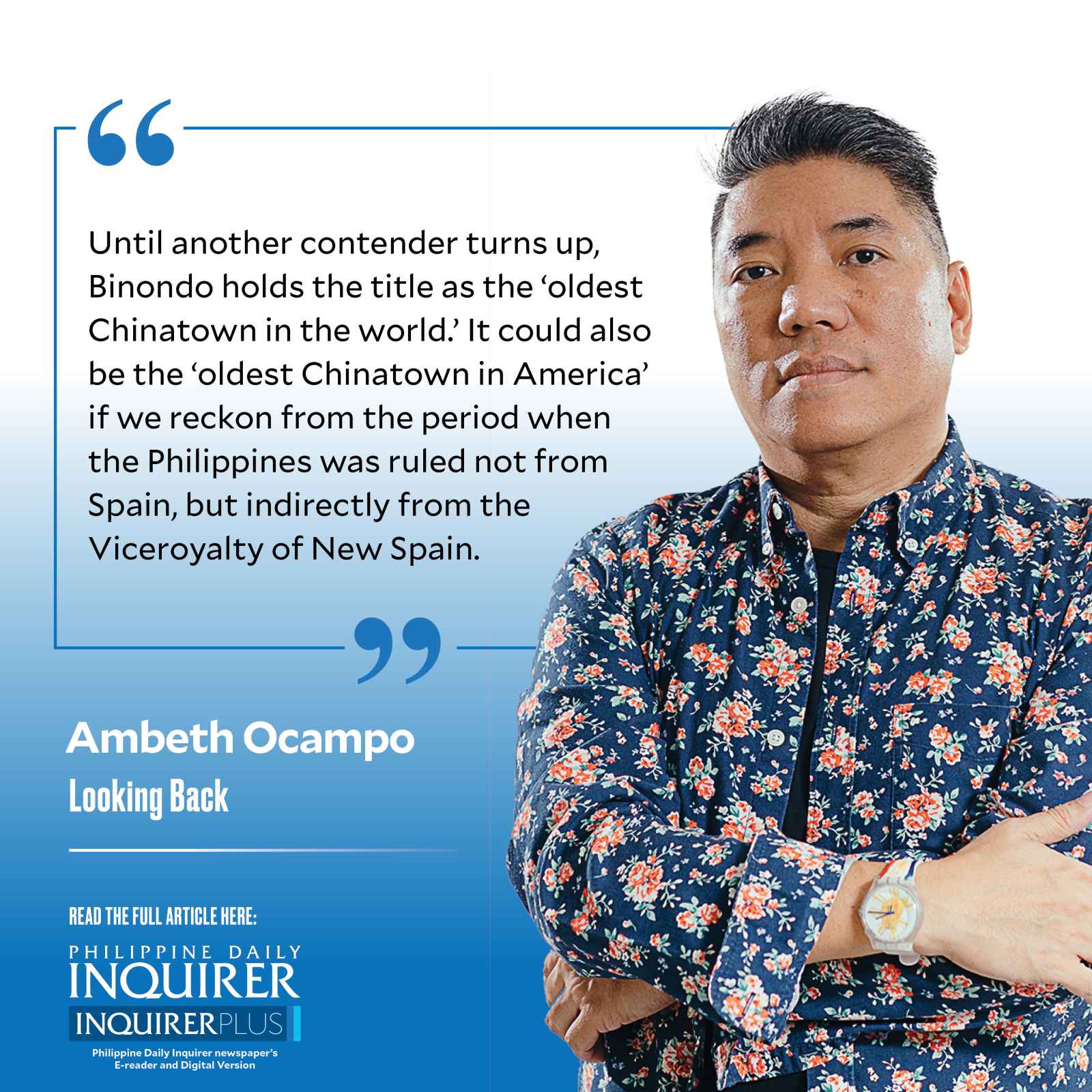Binondo: Oldest Chinatown in the world

Until another contender turns up, Binondo holds the title as the “oldest Chinatown in the world.”
It could also be the “oldest Chinatown in America” if we reckon from the period when the Philippines was ruled not from Spain, but indirectly from the Viceroyalty of New Spain. That is, from 1565 to the independence of Mexico in 1821.
Binondo was established, in 1594, as a settlement for converted Chinese, and placed under the care of the Dominicans. At the time, the settlement for non-Christian Chinese was known as the Parian. This center of commerce and immigration was located outside Intramuros and within range of Spanish cannons. It was located where the Metropolitan Theater and the old Manila Post Office, and Liwasang Bonifacio stand today. Parian might have been older, but since it is no more, the title, oldest existing Chinatown in the Philippines, rests firmly on Binondo.
There is so much material on the Chinese in the Philippines lying in wait within the 55-volume collection of documents from 1493-1898 known as “The Philippine Islands,” compiled by Emma Helen Blair and James Alexander Robertson. Sixteen pages of references on the Chinese can be browsed in the index, quite a lot compared to 36 pages dedicated to Filipinos.
Chinese references begin with racial characteristics like: Chinese being from similar stock as native Filipinos. They are described as “a peculiar people” who were hostile to and abandoned their native country. Chinese were compared with Germans and Malabars. They were morally compared with Filipinos and found to be wanting. After all, they introduced many things into the islands and their people, the most nefarious of all being sodomy.
Physically, they had small eyes and let their fingernails grow long. They were well-built, well-clothed, strong, and robust. Some accounts described them as filthy and being gluttons. Some of their positive traits were: humility, politeness, intelligence, modesty, generosity, patience, etc.
Their negative traits, double that of the positive, were listed as: barbarous, mean, impudent, importunate, deceitful, avaricious, greedy, cowardly, lustful, licentious, and addicted to sodomy and secret sins (on this can be found many citations!). The Chinese were further described as: tyrannical, superstitious, lazy, ignorant, superstitious, mercenary, covetous, treacherous, unscrupulous, and addicted to bribery, gambling, and opium.
They had no conscience and committed perjury. They were: talkative, extortionate, inclined to sorcery, distrustful of foreigners, possess little energy, and were inclined to theft and murder, and given to intrigue. They were submissive to authority, were partial to scarlet, Castillian cloth, and deerskin, but were said to sell their children. They even had a fear of battle, horses, and men with blue eyes.
The Chinese were a mainstay of the economy due to their occupations, whether suitable or not. In some cases they were so good, they could displace Filipinos as: farmers, gardeners, hucksters, fishermen, hunters, bakers (they knew how to adulterate bread!), confectioners, butchers, and salt-makers. They were good as mechanics and skilled artisans. They could raise swine and could work as: charcoal burners, mine workers, carpenters, painters, sawyers. The Philippines being an archipelago, the Chinese were helpful in shipbuilding and could be: sailors, calkers, rowers, and pilots. They made good stone workers as: masons, quarrymen, lime-burners, and day laborers. They were: cobblers, tailors, weavers, candlemakers, chairmakers, barbers, locksmiths, porters, interpreters, apothecariests, herbalists, printers, bookbinders, booksellers, jewelers, painters, sculptors, artists, embroiderers, carvers, architects, accountants, and much more.
The Chinese were famous for fireworks and good in trade: providing credit, establishing guilds, etc. They knew how to value and absorb money. When money was in silver coins, they placed chops on them for authentication, just as moneychangers do today on $100 bills.
The Chinese knew how to clip silver from the coins and refused such coins. They acted as middlemen and usurers, and during the British occupation, some were executed for counterfeiting money. Their merchandise was cheap and not durable just like today.
They were accused of fraud and were said to come to Manila poor, but return to China rich as they traded with everyone: Filipinos, Spaniards, Portuguese, Japanese, English, Dutch, Tartars, Borneans, and Ternateans. In some areas, they actually displaced Spaniards in trade.
Finally, they had a tendency to revolt, and more than a page of references detail various insurrections, four in particular, in the 17th century: 1603, 1639-1640, 1662, 1686, and even during the British occupation, 1762-1764 when they inspired natives against the Spaniards. The Chinese drank hot water, used chopsticks, and ate snakes. They introduced pearl sago and adulterated food. All of these bits of information drawn from the index to Blair and Robertson underscore how important the Chinese have been to Philippine life then as now.
—————–
Comments are welcome at aocampo@ateneo.edu




















